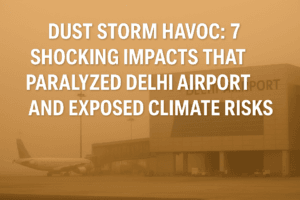Dust Storm Havoc: 7 Shocking Impacts That Paralyzed Delhi Airport and Exposed Climate Risks
A fierce dust storm battered Delhi-NCR on Friday evening, triggering chaos as 15 flights were diverted from Indira Gandhi International Airport and dozens delayed across northern India. The India Meteorological Department (IMD) issued an orange alert, warning of thunderstorms, 80 kmph winds, and potential damage to crops and infrastructure. Residents scrambled to secure homes amid falling trees and traffic snarls, while the storm briefly improved air quality from “poor” to “moderate.”
The IMD urged citizens to avoid open areas, unplug electronics, and stay indoors. Regional impacts included Himachal Pradesh’s orange alert for hailstorms and rainfall-induced landslides in Mandi. The event highlights growing climate vulnerabilities, with experts stressing the need for weather-resilient infrastructure as unseasonal storms intensify.

Dust Storm Havoc: 7 Shocking Impacts That Paralyzed Delhi Airport and Exposed Climate Risks
A ferocious dust storm swept through Delhi-NCR on Friday evening, plunging the city into chaos and leaving travelers stranded as flight operations at Indira Gandhi International Airport came to a grinding halt. At least 15 flights were diverted to alternate airports, while delays cascaded across northern India’s airspace, exposing the vulnerability of infrastructure to extreme weather events.
The Human Toll: From Stranded Passengers to Uprooted Trees
The storm’s fury was felt beyond the tarmac. Residents scrambled to seal homes against invading dust clouds, while falling trees blocked key roads, including the Delhi-Gurugram Expressway. Local vendor Rajesh Kumar recounted, “Within minutes, the sky turned orange. My stall overturned—I’ve never seen winds this strong in April.” Emergency services reported at least 12 injuries from debris-related incidents.
Meteorologists at the India Meteorological Department (IMD) traced the storm to a collision between western disturbances and rising temperatures. “This is typical pre-monsoon volatility, but the intensity is worrying,” noted Dr. Ananya Verma, IMD scientist. The agency issued an orange alert, urging residents to avoid open areas and prepare for 80 kmph winds through the weekend.
Airport Crisis: A Wake-Up Call for Climate Resilience?
Delhi Airport’s real-time diversion of flights to Jaipur, Lucknow, and Ahmedabad prevented accidents but stranded thousands. “We’ve activated monsoon protocols early, deploying extra staff to manage passenger needs,” said airport spokesperson Neha Gupta. Aviation experts, however, question preparedness. “With climate change, such events will recur. Airports need all-weather landing systems,” argued aviation analyst Jatin Malhotra.
Data reveals a pattern: Flight diversions in Delhi have risen 40% since 2022 due to weather disruptions. Friday’s chaos reignited debates about expanding alternate runways and improving pilot training for low-visibility landings.
Health and Environment: A Silver Lining?
While the storm disrupted life, it temporarily scrubbed Delhi’s air. PM2.5 levels dropped to 85 µg/m³ post-storm, offering brief respite from the usual “poor” AQI (164). Pulmonologist Dr. Arvind Singh cautioned, “Dust storms bring coarse particles that aggravate asthma. Masks are essential.”
Farmers in neighboring Haryana and Rajasthan faced crop damage, compounding woes from unseasonal rains. “My wheat harvest was ready—now half is buried under dust,” lamented Karnal farmer Suraj Mehta.
Beyond Delhi: Regional Ripples
Himachal Pradesh battled its own weather war, with orange alerts for hailstorms in Chamba and Kullu. Mandi district recorded 19 mm rain, triggering landslide warnings. Meanwhile, Mumbai grappled with a separate crisis as authorities hunted the owner of an illegal billboard that collapsed during thunderstorms, killing 12.
The Road Ahead: Forecast and Precautions
IMD predicts thunderstorms with 20°C lows in Delhi this weekend. Key precautions include:
- Securing loose outdoor objects
- Avoiding concrete shelters during lightning
- Monitoring flight updates via apps like AirSewa
- Asthmatics keeping inhalers accessible
As climate scientists link rising dust storms to deforestation and erratic rainfall, Friday’s disruption serves as a stark reminder: Urban hubs must innovate to weather the storm. For now, Delhiites watch the skies, hoping calm returns before Monday’s rush hour.
Why This Matters: Extreme weather isn’t just breaking headlines—it’s breaking infrastructure. As India’s aviation and urban systems face climate stress, adaptation is no longer optional. This storm underscores the urgent need for resilient cities, smarter agriculture, and public awareness to mitigate what’s becoming the new normal.
You must be logged in to post a comment.